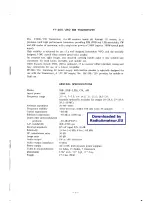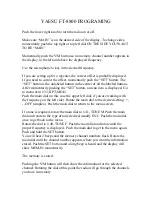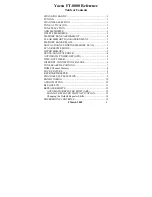
DTR-4630
I.R.T. Communications Pty Ltd | www.irtcommunications.com
Page 11 of 17
Revision 02
OPERATION
The DTR-4630 is primarily designed for use as an optical transmitter and receiver unit built into the one card, though it
can be operated independently as an optical transmitter or optical receiver only device. The DTR-4630 is fully operable
with previous IRT single channel 3G, HD or SD fibre links.
Separate optical transmit and optical receive fibre connectors are provided on the rear of the card with the upper
connector being the optical transmitter output and the lower connector being the optical receiver input.
Optionally a 1300/1550nm wave division multiplexer (WDM) can be fitted to the DTR-4630 to allow simultaneous
transmit and receive functions on the one fibre. Only one optical connector is supplied when fitted with the WDM
option. When fitted with the WDM option, due to the 1300/1550nm split of the WDM device, and being used as a
pair, one DTR-4630 must be fitted with a 1310nm (or 1260-1360nm) transceiver and the other with a 1550nm (or
1520-1600nm) transceiver.
The default setting of the DTR-4630 is automatically set to operate at either
2.97 Gb/s 3G-SDI
,
1.485 Gb/s HD-SDI
or
270 Mb/s SD-SDI
(or
ASI
) and does not require any adjustments prior to use. However, either DIP switch or SNMP
settings allow the unit to be set for SD only, SD/HD only or reclocker bypass modes.
A 2.97 Gb/s 3G-SDI signal, 1.485 Gb/s HD-SDI signal or a 270 Mb/s type of signal, such as ASI or SDI, is connected to
a 75 Ω BNC connector (IN 1) on the rear assembly of the DTR-4630 fibre optic transceiver. Front panel LEDs
indicates the presence and data rate of a valid input signal.
A second input (IN 2) can be automatically switched to the optical output (if enabled) on loss of a valid input signal
to IN 1. On resumption of a valid signal to IN 1 the transmitter section automatically switches back to the IN 1
input.
If the laser is set for permanent operation, on loss of an input signal, a 54MHz oscillator is switched into the optical
output so that the optical receiver still recognizes the optical link as being valid. This 54MHz signal does not affect
the signal reclocking detect circuitry of the receiver section, which is used in signal presence/alarm indication on
detection or absence of a valid 3G, HD or SD signal.
Single mode optical cable is directly connected to the module at the rear of the unit. Likewise the fibre connection
at the far end of the fibre optic cable is directly connected to the rear of the receiver.
The system will operate with an optical path loss from 9dB to a maximum of 27dB (for 3G-SDI signals. Typically
>30dB for HD/SD-SDI signals) when fitted with an APD detector, and from 3dB to a maximum of 18dB when fitted
with a PIN detector. An orange LED ‘Optical’ indicator on the front panel, and a relay alarm accessible by the rear
assembly, indicates when the optical path loss is approaching, or has exceeded, the maximum allowed. For path
lengths <9dB optical loss when using an APD detector, or <3dB optical loss when using a PIN detector, an optical
attenuator is required. The length of fibre that this corresponds to depends on the fibre loss characteristics at the
relevant wavelength of the laser module chosen. For example, if the fibre loss characteristic of the chosen fibre is
0.2dB per kilometre at 1550 nm, say, then the maximum distance that can be run is 135 km (27dB/0.2dBkm),
although connector losses, such as through patch lead connectors etc., should also be taken into consideration
when calculating maximum distances. Actual attenuation versus wavelength characteristics depends upon optic
fibre manufacturer’s own specifications. Also a few dB headroom is recommended to allow for the effects of laser
aging over time.
The output of the DTR-4630 receiver section is the same signal that was originally inputted to the opposite
DTR-4630 transmitter section. Front panel green LEDs indicate the presence of a valid locked 3G-SDI, HD-SDI, or an
SD-SDI type of output signal.
Through the use of SNMP (see separate section of manual) it is possible to remotely monitor and control various
functions not available via the local DIP switch control. Such as, for example, it is possible to disable the channel on
either or both the transmitter (Tx) and receiver (Rx) sections locking out an end user’s functionality should this be
desired. When a channel (Tx or Rx) has been disabled, should an electrical signal be present, the corresponding
data rate LED will flash - not to be confused with situation as described in
Front Panel LED Indicators
section below.



































